
Giacomo Puccini February 2010 Events in Lucca
TUTTI I LUNEDI’, MARTEDI’ E MERCOLEDI’ DEL MESE /EVERY MONDAY, TUESDAY AND WEDNESDAY OF THE MONTH
SPECIAL CONCERTS
“PUCCINI AND MOZART”
(always with different performers and programmes)
TUTTI I VENERDI’ DEL MESE – EVERY FRIDAY OF THE MONTH
MOZART & PUCCINI
Arie e duetti da/arias and duets from LE NOZZE DI FIGARO, COSI’ FAN TUTTE, DON GIOVANNI, MADAMA BUTTERFLY, LA BOHEME, TOSCA
TUTTI I SABATO DEL MESE – EVERY SATURDAY OF THE MONTH
UNA NOTTE ALL’OPERA/A NIGHT AT THE OPERA
Arie e duetti dal repertorio lirico di Puccini, Verdi, Leoncavallo, Donietti, Mascagni ed altri/arias and duets from the Italian operatic repertoire
TUTTE LE DOMENICHE DEL MESE – EVERY SUNDAY OF THE MONTH
PUCCINI E LA CANZONE TRADIZIONALE NAPOLETANA – PUCCINI & THE NEAPOLITAN TRADITIONAL SONGS



